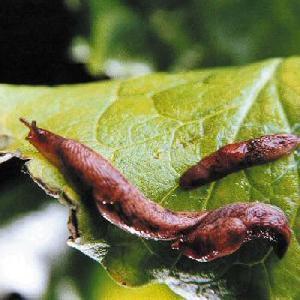Slug Damage
Slug damage can be recognised by the irregular holes with smooth edges they make on leaves and nearby will be evidence of their slime trials. They are particularly fond of succulent seedlings, which when left unprotected, can be totally destroyed in a single night. If your seeds do not seem to have germinated, it is possible and even likely that slugs have devoured the emerging seedlings underground.
As well as attacking the leafy parts of plants, slugs will also feast on your fruit and vegetable crop. Slugs will chew holes in your ripening strawberries and tomatoes. Potatoes are particularly vulnerable, since they are attacked without the slugs having to leave the safety of being underground.
Slugs love potatoes, which are of course grown underground, so you cannot see them being attacked.
Nemaslug Slug Killer
Nemaslug controls all common species of small to medium sized slugs (up to 8cm – 2.5-3 inches). Start your control regime early and you will be able to target the young slugs growing under the ground feeding on humus.
Nemaslug uses the nematode Phasmarhabditis hermaphrodita, which was discovered by scientists at the government research institute at Bristol, England.
One application of Nemaslug provides an incredible 300,000 nematodes for every square metre of soil, giving at least six weeks control of slugs. This is generally enough time for seedlings and bedding plants to get well established.
Nemaslug is easy to apply and does not leave any unsightly residues. The majority of the slugs will die underground, so don’t expect to see dead slugs lying around. Any slugs that do die on the surface or are eaten by birds or hedgehogs will do no harm. The nematode only hurts the slug. Conventional slug pellets make the slug poisonous to our helpful friends so reducing the predator and increasing the need for the pellets.
Apply Nemaslug to moist soil. The soil temperature should be 5ºC (40ºF) or over (this is when plants start to grow). Nematodes are capable of surviving the odd frost; so don’t worry if the temperature falls after you have applied Nemaslug. Metaldehyde (poisonous to our garden friends) based slug pellets are reported not to be effective below 7ºC.
“Keen Gardeners across the UK are reaping the benefits of this miraculous discovery….you won’t be disappointed.” RHS The Garden May 2006
Unlike some controls, Nemaslug continues to work well during wet weather – exactly when you need protection against slugs!
More Information Available from Allotment Shop Here
Nemaslug can be kept in the fridge for up to three weeks before application so if you can’t apply immediately you can hold until you are ready to apply.





Hi,
Thanks for the information on the nematode, we’ve been looking all over for natural slug killers seeing as we are not allowed to have a pond and froggy slug chompers on the site.
Yours gratefully,
Dave
hi im useing slug pellets in my garden will the pellets kill any birds or pigeons thank u so much stuart
There have been concerns about metaldahyde (normal) slug pellets poisoning birds who eat the poisoned slugs but I don’t knopw of any evidence to prove it. Certainly they are dangerous to pets (or people) if eaten but they do contain a repellent and if scattered lightly – never pile them up – that’s pretty unlikely to happen.
Growing Success pellets contain ferramol and these are supposed to be 100% safe for pets and wildlife. I use these myself as I don’t want to risk any harm to our pets. You can get them from Harrod Horticultural here.
Why can we not get this product in New Zealand? Is there a firm who will supply this to a New Zealand address?
Hi Sheila – I’m sorry but I don’t know about New Zealand. If you don’t have these nematodes naturally I suppose they’re going to be very cautious about introducing them into your eco-system, with good reason.
We’ve seen the effects of your flat worm here that eats our worms. Unexpected consequences of importing plants.
Try asking in your local gardening centres – they might know.
I have used this on my garden before but now want to use it on my new allotment. I seem to remember that it has to be applied using a hose though we do not have hoses at our allotments. Is there any other way it can be applied?
You apply the nematodes in solution but not via a hose, a watering can is usual.
I have just returned to South Africa after visiting my daughter in England. She was expounding the vertues of Nemaslug. Could you please let me know if it is avail here. Thank you
I’m sorry Rose, I don’t have a clue about South Africa or any other country apart from the UK for that matter. There could be very good ecological reasons not to use them where they do not live naturally.